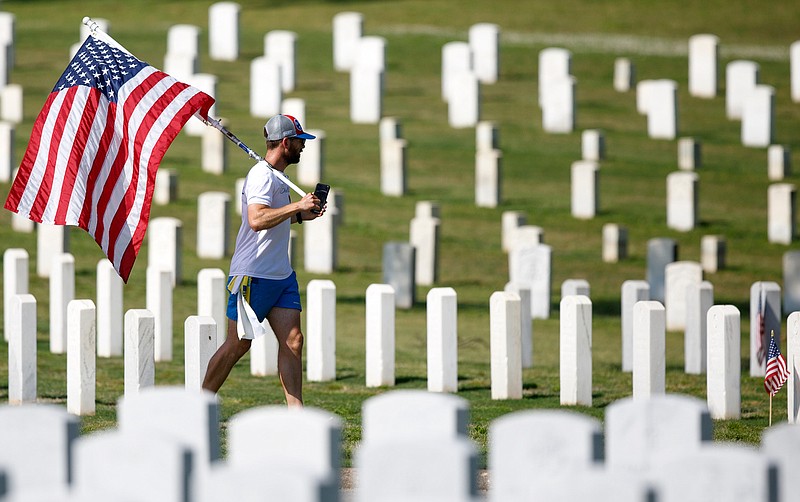As we reflect on a 4th of July punctuated with U.S. flags, moments of rereading the words of promise in the Declaration of Independence and our commitment to make those promises a reality for all citizens, and remembrance of time spent safely celebrating with family and friends, many among us also pause to consider the cost of freedom. In Chattanooga and Hamilton County, perhaps no single historic property more vividly reminds us of the promise of liberty, equality and justice than the Chattanooga National Cemetery.
While the Department of Veterans Affairs maintains 143 national cemeteries, most Hamilton County residents share a belief that our Chattanooga National Cemetery is not only one of the most beautiful and sacred sites, but its history establishes it among the most memorable.
Most local residents are familiar with the name Maj. Gen. George H. Thomas. Few stories about the Union victories during the Battles for Chattanooga can be told without some reference to Thomas and his leadership. The victory in Chattanooga, following the intense fighting on Nov. 23-27, 1863, assured a Union drive into the heart of Georgia and South Carolina. What few remember is that Thomas was forced to select a burial site for the casualties, seizing 75 acres that would later be purchased from three local residents, Joseph Ruchs, Robert Hooke and J.R. Slayton. The site chosen featured a rounded hill that had served as Gen. Ulysses Grant's headquarters during the early hours of the battle for Lookout Mountain. The fact that the Chattanooga National Cemetery was officially "born" on Christmas Day, 1863, when Thomas signed General Order No. 296 creating the cemetery, adds a unique twist to the story.
The rocky terrain that today distinguishes the site was evident as the cemetery was developed. Chaplain Thomas Van Horn noted in an 1866 report to the U.S. Army that almost one-third of the site could not be used for burials because of the rocky outcroppings but that he had created a design that would use the beauty of the rock formations to accentuate the cemetery. His report noted that he had already incorporated flowering shrubs and trees along with evergreens that would provide year-round beauty.
The official name, Chattanooga National Cemetery, was chosen in 1867 and reinternments from other sites began. By 1870, dead from not only the Chattanooga battles and the local military hospitals had been relocated, but others from Charleston, Athens, Bridgeport and Stevenson along with those who died during Sherman's march to Atlanta and others who had perished during the crossing of the Tennessee River at Decatur were moved to the new cemetery. Those graves included almost 1,800 "unknown soldiers" who died at the Battle of Chickamauga.
From that solemn beginning, the Chattanooga National Cemetery has steadily grown during the 157 years since the first burials, including additional acreage that brought the site to about 121 acres. More than 44,000 veterans are buried at the site, including one Revolutionary War veteran. It is also the only national cemetery featuring graves of prisoners of war from both World War I and World War II.
A planned visit to the Chattanooga National Cemetery, entered from Holtzclaw Avenue, should include these additional points:
* While most are aware that Medal of Honor recipients Andrews Raiders (four), Desmond Doss and Ray Duke are buried on site, many may be unaware that Pvt. William F. Zion, USMC, Medal of Honor for valorous action during the Boxer Rebellion, is also buried at the Chattanooga National Cemetery.
* The Circle of Honor, at the highest point in the cemetery, features specific veteran memorials.
* The Armed Forces Pavilion, near the lake, serves as the gathering point for commemorative events, including Veterans Day, Memorial Day, Vietnam Veterans Appreciation Day and the annual Wreaths Across Chattanooga ceremony. Interestingly, while residents often assume the Christmas wreaths are provided by the U.S. government, individual donations pay for the wreaths with a goal of eventually providing a wreath for every grave. [https://www.chattanoogawaa.com/]
* The 1868 4th Army Corps Monument, a granite obelisk honoring the fallen regiment members, provides a solemn reminder of the comradeship shared by military veterans.
* The original entrance, an elaborate stone arch, adds a sense of past glory to the rolling hills and the thousands of white headstones.
A visit to the Chattanooga National Cemetery reminds us of Franklin D. Roosevelt's words, "Those who have long enjoyed such privileges as we enjoy forget that men have died to win them."
Linda Moss Mines, the Chattanooga-Hamilton County historian, is secretary of the Chattanooga Area Veterans Council and regent, Chief John Ross Chapter.
